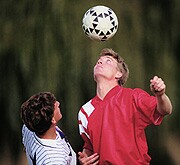
SUNDAY, Jan. 15 (HealthDay News) — Soccer players need to use the correct techniques when “heading” — using their unprotected head to stop or redirect the ball — to prevent possible brain injury, researchers say.
Although researchers have not yet proven a link between the sport and brain damage, Dr. Alejandro Spiotta and other experts from the Cleveland Clinic said soccer balls are moving at high speeds when they come into contact with players’ heads, putting athletes at risk for a possible traumatic brain injury.
“Even if the cognitive impairment were to be mild, it would still present a major medical and public health concern because of the massive volume of soccer players worldwide,” Spiotta and colleagues wrote. “Any possible detrimental effect may only become clinically evident decades in the future.”
In their review of existing research, published in the January issue of Neurosurgery, the researchers said caution about heading must be used at all levels of soccer. They advised that children use age-appropriate balls until they develop the neck strength and body control necessary for correct heading technique.
English soccer player Jeffrey Astle, who had a reputation as a fierce header, died with degenerative brain disease in 2002. The brain damage he sustained was similar to chronic traumatic encephalopathy, a degenerative brain disease seen in football players and other athletes, the researchers said in a journal news release.
The researchers noted that soccer balls are no longer made of leather and do not absorb moisture, which may make them safer for heading. Also, a debate about the use of soft headgear to help protect players’ heads is ongoing.
The review concluded that more research is needed to determine the long-term effects of heading on soccer players’ brains.
More information
The American Association of Neurological Surgeons provides more information on sports-related brain injury.

